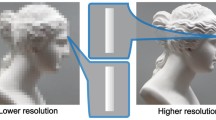Abstract
Binocular disparity, a primary cue for stereoscopic depth perception, is widely represented in visual cortex. However, the functional specialization in the disparity processing network remains unclear. Using magnetic resonance imaging-guided transcranial magnetic stimulation, we studied the causal contributions of V3A and MT+ to stereoscopic depth perception. Subjects viewed random-dot stereograms forming transparent planes with various interplane disparities. Their smallest detectable disparity and largest detectable disparity were measured in two experiments. We found that the smallest detectable disparity was affected by V3A, but not MT+ , stimulation. On the other hand, the largest detectable disparity was affected by both V3A and MT+ stimulation. Our results suggest different roles of V3A and MT+ in stereoscopic depth processing.




Similar content being viewed by others
Availability of data and material
The data that support the findings of this study are available upon request.
References
Allen EA, Pasley BN, Duong T, Freeman RD (2007) Transcranial magnetic stimulation elicits coupled neural and hemodynamic consequences. Science 317(5846):1918–1921
Anzai A, DeAngelis GC (2010) Neural computations underlying depth perception. Curr Opin Neurobiol 20(3):367–375
Backus BT, Fleet DJ, Parker AJ, Heeger DJ (2001) Human cortical activity correlates with stereoscopic depth perception. J Neurophysiol 86(4):2054–2068
Brainard DH (1997) The psychophysics toolbox. Spat Vis 10(4):433–436
Cai P, Chen N, Zhou T, Thompson B, Fang F (2014) Global versus local: double dissociation between MT+ and V3A in motion processing revealed using continuous theta burst transcranial magnetic stimulation. Exp Brain Res 232(12):4035–4041
Carmel D, Walsh V, Lavie N, Rees G (2010) Right parietal TMS shortens dominance durations in binocular rivalry. Curr Biol 20(18):R799–R800
Chowdhury SA, DeAngelis GC (2008) Fine discrimination training alters the causal contribution of macaque area MT to depth perception. Neuron 60(2):367–377
Cocchi L, Sale MV, Lord A, Zalesky A, Breakspear M, Mattingley JB (2015) Dissociable effects of local inhibitory and excitatory theta-burst stimulation on large-scale brain dynamics. J Neurophysiol 113(9):3375–3385
Cottereau BR, McKee SP, Ales JM, Norcia AM (2011) Disparity-tuned population responses from human visual cortex. J Neurosci 31(3):954–965
Cumming BG, DeAngelis GC (2001) The physiology of stereopsis. Annu Rev Neurosci 24:203–238
DeAngelis GC, Cumming BG, Newsome WT (1998) Cortical area MT and the perception of stereoscopic depth. Nature 394:677–680
DeAngelis GC, Newsome WT (1999) Organization of disparity-selective neurons in macaque area MT. J Neurosci 19(4):1398–1415
Engel SA, Glover GH, Wandell BA (1997) Retinotopic organization in human visual cortex and the spatial precision of functional MRI. Cereb Cortex 7(2):181–192
Goncalves NR, Ban H, Sánchez-Panchuelo RM, Francis ST, Schluppeck D, Welchman AE (2015) 7 tesla FMRI reveals systematic functional organization for binocular disparity in dorsal visual cortex. J Neurosci 35(7):3056–3072
Huang Y-Z, Edwards MJ, Rounis E, Bhatia KP, Rothwell JC (2005) Theta burst stimulation of the human motor cortex. Neuron 45(2):201–206
Julesz B (1960) Binocular depth perception of computer-generated patterns. Bell Syst Tech J 39:1125–1162
Krug K, Parker AJ (2011) Neurons in dorsal visual area V5/MT signal relative disparity. J Neurosci 31(49):17892–17904
Kumar T, Glaser DA (1992) Depth discrimination of a line is improved by adding other nearby lines. Vis Res 32(9):1667–1676
Maunsell JH, Van Essen DC (1983) Functional properties of neurons in middle temporal visual area of the macaque monkey. II. Binocular interactions and sensitivity to binocular disparity. J Neurophysiol 49:1148–1167
Minini L, Parker AJ, Bridge H (2010) Neural modulation by binocular disparity greatest in human dorsal visual stream. J Neurophysiol 104(1):169–178
Neri P, Bridge H, Heeger DJ (2004) Stereoscopic processing of absolute and relative disparity in human visual cortex. J Neurophysiol 92(3):1880–1891
Parker AJ (2007) Binocular depth perception and the cerebral cortex. Nat Rev Neurosci 8:379
Parker A, Yang Y (1989) Spatial properties of disparity pooling in human stereo vision. Vis Res 29:1525–1538
Poggio GF (1995) Mechanisms of stereopsis in monkey visual cortex. Cereb Cortex 5:193–204
Preston TJ, Li S, Kourtzi Z, Welchman AE (2008) Multivoxel pattern selectivity for perceptually relevant binocular disparities in the human brain. J Neurosci 28(44):11315–11327
Qian N (1997) Binocular disparity and the perception of depth. Neuron 18:359–368
Roy JP, Komatsu H, Wurtz RH (1992) Disparity sensitivity of neurons in monkey extrastriate area MST. J Neurosci 12:2478–2492
Rutschmann RM, Greenlee MW (2004) BOLD response in dorsal areas varies with relative disparity level. NeuroReport 15(4):615–619
Sereno MI, Dale A, Reppas J et al (1995) Borders of multiple visual areas in humans revealed by functional magnetic resonance imaging. Science 268(5212):889–893
Tsao DY, Vanduffel W, Sasaki Y et al (2003) Stereopsis activates V3A and caudal intraparietal areas in macaques and humans. Neuron 39(3):555–568
Uka T, DeAngelis GC (2003) Contribution of middle temporal area to coarse depth discrimination: comparison of neuronal and psychophysical sensitivity. J Neurosci 23(8):3515–3530
Uka T, DeAngelis GC (2006) Linking neural representation to function in stereoscopic depth perception: roles of the middle temporal area in coarse versus fine disparity discrimination. J Neurosci 26(25):6791–6802
van Kemenade BM, Muggleton N, Walsh V, Saygin AP (2012) Effects of TMS over premotor and superior temporal cortices on biological motion perception. J Cogn Neurosci 24:896–904
Watson AB, Pelli DG (1983) QUEST: a Bayesian adaptive psychometric method. Percept Psychophys 33(2):113–120
Westheimer G (1979) Cooperative neural processes involved in stereoscopic acuity. Exp Brain Res 36(3):585–597
Westheimer G (1986) Spatial interaction in the domain of disparity signals in human stereoscopic vision. J Physiol 370:619–629
Wheatstone C (1838) XVIII. Contributions to the physiology of vision—part the first. On some remarkable, and hitherto unobserved, phenomena of binocular vision. Philos Trans R Soc Lond 128:371–394
Acknowledgements
This work was supported by NSFC 31930053 and NSFC 31971031. We thank Siyuan Cheng for proofreading.
Funding
This work was supported by NSFC 31930053 and NSFC 31971031.
Author information
Authors and Affiliations
Contributions
All authors contributed to the study conception and design. Material preparation, data collection, and analysis were performed by NC and ZC. The first draft of the manuscript was written by NC and ZC. All authors revised the manuscript.
Corresponding authors
Ethics declarations
Conflict of interest
The authors declare no conflicts of interest.
Ethics approval
The experimental procedures and protocols have been approved by the human subject review committee of Peking University.
Consent to participate
All subjects gave written, informed consent in accordance with the procedures and protocols approved by the human subject review committee of Peking University.
Consent for publication
We confirm that we have given due consideration to the protection of intellectual property associated with this work and that there are no impediments to publication.
Code availability
The codes for stimuli presentation of this study are available upon request.
Additional information
Communicated by Melvyn A. Goodale.
Publisher's Note
Springer Nature remains neutral with regard to jurisdictional claims in published maps and institutional affiliations.
Rights and permissions
About this article
Cite this article
Chen, N., Chen, Z. & Fang, F. Functional specialization in human dorsal pathway for stereoscopic depth processing. Exp Brain Res 238, 2581–2588 (2020). https://doi.org/10.1007/s00221-020-05918-4
Received:
Accepted:
Published:
Issue Date:
DOI: https://doi.org/10.1007/s00221-020-05918-4




